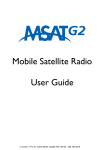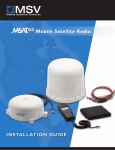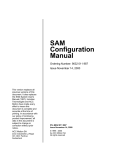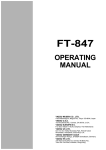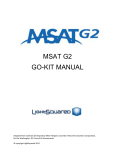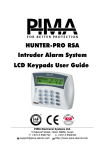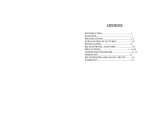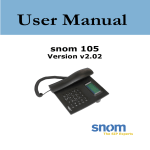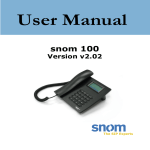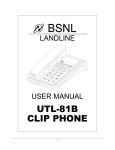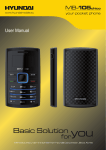Download user interface (ui) - Chroma Communications Inc.
Transcript
Mobile Satellite Radio USER GUIDE Copyright © 2005 SKYTERRA All rights reserved. This publication and its contents are proprietary to SkyTerra Communications, LP. No part of this publication may be reproduced in any form or by any means without the written permission of SkyTerra Communications, LP, 10802 Parkridge Boulevard, Reston, VA 20191-4334 SkyTerra Communications, LP, has made every effort to ensure the correctness and completeness of the material in this document. SkyTerra Communications, LP, shall not be liable for errors contained herein. The information in this document is subject to change without notice. SkyTerra Communications, LP, makes no warranty of any kind with regard to this material, including, but not limited to, the implied warranties of merchantability and fitness for a particular purpose. Trademarks All trademarks, marks, names, or product names referenced in this publication are the property of their respective owners, and SkyTerra Communications, LP, neither endorses nor otherwise sponsors any such products or services referred to herein. SkyTerra is a trademark of SkyTerra Communications, LP. MCN: 3004073-0001 rev. B SAFETY INFORMATION For your safety and protection, read this entire user manual before you attempt to use the MSAT-G2 Radio. In particular, read this safety section carefully. Keep this safety information where you can refer to it if necessary. WARNING SYMBOLS USED IN THIS MANUAL WARNING Potential radio Frequency (RF) hazard. Where you see this alert symbol and WARNING heading, strictly follow the warning instructions to avoid injury to eyes or other personal injury. WARNING Where you see this alert symbol and WARNING heading, strictly follow the warning instructions to avoid personal injury. DANGER Electric shock hazard: Where you see this alert symbol and DANGER heading, strictly follow the warning instructions to avoid electric shock injury or death. User Guide i WARNINGS FOR THE MSAT-G2 RADIO SAFETY INFORMATION The MSAT-G2 Mobile Satellite Radio is a radio transmitter and receiver. When turned on and operating, the MSAT-G2 antenna transmits and receives radio frequencies to and from a satellite orbiting the earth. Installed and used properly the MSAT-G2 Radio complies with the following safety standard: “ANSI/IEEE C95.1-1992, Safety Levels With Respect to Human Exposure to Radio Frequency Electromagnetic Fields, 3KHz to 300 GHz.” Testing of the MSAT-G2 Radio design indicates that, in accordance with ANSI/IEEE C95.1-1992, The MSAT-G2 radio may be operated safely if no one is within 39 inches (1 meter) of the satellite antenna’s transmission path. The antenna should be installed and operated to ensure that passersby and passengers of vehicles with vehicle-mounted antennas will not be closer than the safe distance. There is a label on the antenna that notifies people of the safe distance. Please be sure that the label on the antenna remains visible and attached, If detached replace immediately. Use of the MSAT-G2 Radio in a manner that is inconsistent with the safety guidelines stated in this manual may result in physical harm or other harm to your health. DO NOT STAND IN FRONT OF THE ANTENNA This device emits radio frequency energy when in the transmit mode. To avoid injury, do not place head or other body parts in front of the satellite antenna when system is operational. Maintain a distance of one meter away from the front of the MSAT-G2 antenna. OTHER ELECTRONIC DANGER WARNING To reduce the risk of fire or electric shock, do not submerse this product in water. Do not expose this product to rain or moisture unless it is specifically intended for outside use. ii User Guide FUSE REPLACEMENT Replace fuses with the same type and rating for protection against risk of fire. BLAST/RF WARNING Do not operate the MSAT-G2 Radio in areas where explosives are in use as the RF energy may cause hazardous conditions. Do not operate the MSAT-G2 Radio where two-way radios are prohibited. Turn the MSAT-G2 Radio off while at a petrol filling station or near fuels or chemicals. INSTALLATION WARNING This product is to be installed by Authorized Service Centers. The TU requires air cooling. Do not cover the TU or otherwise impede the flow of air across the unit. QUALIFIED SERVICE WARNING Do not disassemble this product as there are no serviceable parts inside. This product should be serviced by an authorized Service Center when service or repair work is required. Personal injury may result if the transceiver unit or antenna unit is opened when power is applied. ACCESSORIES WARNING Use of non-approved accessories can result in loss of performance, damage to the MSAT-G2 Radio, fire, electric shock or injury. CONNECTING DEVICES WARNING Never connect incompatible products. When connecting the MSAT-G2 Radio to any other device, read the device’s User Manual for detailed safety instructions. User Guide iii PACEMAKERS WARNING The various brands and models of cardiac pacemakers available exhibit a wide range of immunity levels to radio signals. If you wear a cardiac pacemaker consult your cardiologist or the device manufacturer prior to using the MSAT-G2 Radio. LIGHTNING PROTECTION WARNING In fixed-site installations, ensure that ground straps and lightning arresters are correctly installed in accordance with approved National Electrical Code standards. FCC COMPLIANCE This equipment has been tested and is compliant with the limits for a class B digital device, pursuant to Part 15 of the FCC rules. These limits are designed to provide reasonable protection against harmful interference in a residential installation. This equipment generates, uses and can radiate radio frequency energy and, if not installed and used in accordance with the instructions, may cause harmful interference to radio communication equipment. However, there is no guarantee that interference will not occur in a particular installation. If this equipment does cause harmful interference to radio or television reception, which can be determined by turning the equipment off and on, the user is encouraged to try to correct the interference by one or more of the following measures: iv 1. Reorient or relocate the receiving antenna. 2. Increase the separation between the equipment and the receiver. 3. Connect the equipment into an outlet on a circuit different from that to which the receiver is connected. User Guide CONTENTS SAFETY INFORMATION ______________________________ I Warning Symbols Used in this Manual .......................................................... i Warnings for the MSAT-G2 Radio................................................................ ii CONTENTS _______________________________________ V INTRODUCTION ___________________________________ 1 MSAT-G2 Mobile Satellite Radio ................................................................... 1 The MSAT Network – Powered by SkyTerra Communications ................. 1 MSAT Dispatch Radio ...................................................................................... 1 Service Highlights .............................................................................................. 2 Coverage............................................................................................................. 2 COMPONENTS AND ACCESSORIES ____________________ 3 RADIO OVERVIEW _________________________________ 4 Transceiver Unit................................................................................................ 4 Handset ............................................................................................................... 4 Antennas ............................................................................................................. 5 USER INTERFACE (UI) OVERVIEW ____________________ 6 Display ................................................................................................................. 7 Indicator Definitions................................................................................. 7 Controls.............................................................................................................. 9 Buttons........................................................................................................ 9 Physical Keys .............................................................................................. 9 Soft Keys...................................................................................................10 Alphanumeric Keyboard Mapping........................................................12 Character Entry.......................................................................................12 Modes ................................................................................................................13 Dispatch Radio Mode.............................................................................13 USER INTERFACE (UI) FUNCTIONS __________________ 15 One-Touch Key Functions............................................................................15 User Guide v Lock/Unlock Talk Group.......................................................................15 GPS ON/OFF...........................................................................................15 PTT Operation ........................................................................................15 Audio Indicators ......................................................................................16 Main Menu ........................................................................................................17 Handset Lock and Unlock .............................................................................17 GPS Menu .........................................................................................................18 GPS On/Off ..............................................................................................18 Save Position ............................................................................................18 Stored Positions ......................................................................................19 Admin Menu .....................................................................................................19 Volume ......................................................................................................20 DR (Dispatch Radio) Admin .................................................................20 X-Over ......................................................................................................21 Backlight ....................................................................................................22 Software Version.....................................................................................23 Serial Port .................................................................................................23 System Menu ....................................................................................................23 Password...................................................................................................24 Lock Code ................................................................................................24 Beam Signal OFF/ON .............................................................................24 TECHNICAL SPECIFICATIONS _______________________ 25 ERROR MESSAGES ________________________________ 26 GLOSSARY ______________________________________ 29 vi User Guide INTRODUCTION MSAT-G2 MOBILE SATELLITE RADIO The MSAT-G2 Mobile Satellite Radio is a powerful new communications tool that works where you do. Designed for use on the MSAT Network, the MSAT-G2 supports continent wide Push-to-Talk (PTT) and Voice communications. In addition, the MSAT-G2 offers GPS capability and flexible interconnectivity to a variety of third- party Interoperability Interfaces, extending the reach of traditional Land Mobile Radio technology. THE MSAT NETWORK – POWERED BY SKYTERRA COMMUNICATIONS SkyTerra Communications is North America’s premier provider of mobile satellite communications. Delivering service since 1996, SkyTerra offers customers a wide choice of wireless Voice and Data services via its two MSAT satellites. SkyTerra provides superior capacity and reliability for customers across North and Central America, northern South America, the Caribbean, Hawaii and in coastal waters. MSAT DISPATCH RADIO MSAT Dispatch Radio is a real-time, voice-based service that provides pointto-multipoint and point-to-point communication at the push of a button enabling users to stay in touch, virtually anywhere. The service is a costeffective alternative to installing, maintaining, and relocating land-based twoway radio communication systems. User Guide 1 SERVICE HIGHLIGHTS The satellite acts like a radio tower, turning the entire continent into a single cell, transmitting signals to and receiving signals from subscribers on the ground. Single Talk Group conversations can accommodate up to 9,999 users. Network level Talk Group prioritization for each radio. Priority-1 interruption feature enabling a user to override a current speaker in the event of an emergency. Dial-in Dispatch feature enabling a user to join a Talk Group conversation from the Public Switched Telephone Network (PSTN). Dial-out Dispatch feature enabling a Talk Group member to dial out to a specific PSTN phone number, bridging the PSTN user into a Talk Group conversation. COVERAGE SkyTerra provides wireless communications on land, sea, or in the air across North and Central America, northern South America, the Caribbean, Hawaii and coastal waters. 2 User Guide COMPONENTS AND ACCESSORIES Standard MSAT-G2 Packages: MSAT-G2 LM MSAT-G2 M MSAT-G2 F (Land Mobile) (Maritime) (Fixed) HUGHES 2100 TU with Mounting Bracket HUGHES 2100 TU with Mounting Bracket HUGHES 2100 TU with Mounting Bracket DT-200 Handset DT-200 Handset DT-200 Handset SPAC-AS-MSV220 Antenna SPAC-ASMSV320 Antenna SPAC-AS-MSV220 Antenna Antenna Cable (20ft) Antenna Cable (60ft) Antenna Cable (150ft) Power Cable (20ft) Power Cable (20ft) Power Cable (20ft) Pole Mounting Kit Optional Accessories: Optional Accessories: Pole Mounting Kit Optional Accessories: Magnetic Mounting Kit Magnetic Mounting Kit Or Pole Mounting Kit Power Supply, External Speaker and Headset are sold separately. User Guide 3 RADIO OVERVIEW TRANSCEIVER UNIT TU Front Panel Mounting Bracket TU Back Panel Power Cable HANDSET DT-200 Series Handset 4 User Guide ANTENNAS SPAC-AS-MSV220 Antenna (Land Mobile & Fixed) SPAC-AS-MSV320 Antenna (Maritime) User Guide 5 USER INTERFACE (UI) OVERVIEW Loudspeaker - High volume speaker in dispatch mode - Earpiece in telephone mode Power Key Switches radio on/off Soft Keys Function changes based upon display text above key P1 Key Emergency Dispatch Radio call End Key Ends calls and provides quick exit from menus PTT Key Push to Talk Send Key Initiates calls Scroll Keys Scrolls through lists and menus, Adjusts volume Alphanumeric Keypad Microphone Headset Jack 6 User Guide DISPLAY The display area contains, at any given time, one or more of the following information sets: Latitude/longitude of current location Dispatch Radio talk group assignment Menus for invoking various actions and functions Status messages Function success, error, or correctional messages “Soft” keys to support various functions More detailed information about the display contents and functionality is detailed in the MMI functions chapter. INDICATOR DEFINITIONS ICONS No Service Icon This indicator signifies that the radio is temporarily out of service. Headset Icon This indicator signifies that a headset is connected to the handset. Talk Group Lock Icon This icon shall appear on the handset display when the talk group lock feature is enabled. POWER UP/DOWN INDICATORS MSAT Logo On power up, the MSAT logo appears for a few seconds. SEARCHING… This indicator signifies that the handset is attempting to log-on to the Network. The indicator is also displayed during this sequence. Once the radio logs on, disappears and the default service display screen is displayed on the handset. If service is lost, the SEARCHING… and indicators are displayed until service is restored. User Guide 7 DISPATCH MODE OPERATION INDICATORS Tag Position (i.e. 01:XXXXXXX ) Once a talk group is successfully downloaded, an associated two digit tag number is assigned by the Network and appears on the display screen. A radio can have up to 16 tag positions (including tag 00 for private mode operation). BX SXX This indicator specifies the beam to which the radio has logged-on, as well as the radio received signal strength (i.e. B1 S55). Beam mapping is as follows: Beam 0 East Beam 1 East Central Beam 2 West Central Beam 3 West Beam 4 South Beam 5 Alaska/Hawaii Signal strength ranges from 0 (no signal) through 99. NO TG This indicator appears in the event that a talk group has not yet been downloaded to the radio. TG UPDATE This indicator appears when a talk group has been successfully downloaded to the radio, reconfigured or deleted from the radio over the air. Talk groups download quickly when the radio is powered on. If the configuration of talk groups is changed at the network while the radio is off, the talk group information will be downloaded via the signaling channel when a call is made or a manual beam cross-over is initiated. DR This indicator appears when the radio is in idle state in Dispatch Radio mode. IN USE This indicator appears when a Dispatch Radio call is in progress. It will remain until the call has been terminated. 8 User Guide USER ON This indicator appears when the PTT key has been pressed and the communication channel has been accessed. The indicator is prompting you to begin speaking. VACANT This indicator appears when the PTT key has been released. It indicates that the communication channel is available to any member of the talk group who wishes to speak. PRIV This indicator appears when you select a private mode talk group (tag 00) and will remain displayed when the handset is in private mode (in idle state). P1 This indicator appears when you initiate a Priority-1 Emergency call. CONTROLS BUTTONS Power: The power button is the “on-off” switch for the handset. It is a “delayed action” button – you must keep it pressed for a second or two and then release it to initiate the power on or power off sequence. PTT: Pressing and holding the PTT button initiates and maintains a Dispatch Radio call. P1: Pressing this key initiates a Priority-1 Emergency Interruption Dispatch Radio call. PHYSICAL KEYS Keypad Keys: The keypad contains alphanumeric keys for text entry and Circuit-Switched Voice number dialing. SEND: This key is used to initiate the Dial-out Dispatch sequence. END: This key is used to Quick exit from any menu through which you are navigating. When you press the key you are returned to the “idle” display screen. UP ARROW/DOWN ARROW: These keys are used primarily for the following functions: Volume adjustment Scrolling through various menus User Guide 9 Scrolling through downloaded talk group tag positions In certain contexts, the Up/Down arrows also serve as “soft keys.” SOFT KEYS Four “soft keys” are used to enable the following functions: Navigation through Menus Storage of data in the radio Selection of Dispatch Radio talk group tag positions Activation/Deactivation of various functions and features These keys are called “soft keys” because the way they work depends on the context of the function currently being exercised on the handset. A soft key “label” is shown above the key in the display area. Soft Key 1 (SK1): This key is located just below the display area and just above the SEND key. Its label is shown directly above it in the display area. Here is a summary of SK1 functionality: MENU – used to access various user menus. The “Menu” soft key indicator is displayed when the radio is in an idle state. CLEAR – used mainly while in editing mode (labeling talk group tag positions, labeling GPS positions, etc.). A single press deletes a single character; press and hold deletes the entire line of text. BACK – used to back out of a given menu. This key generally brings you to the previous menu option without implementing changes (e.g. number storage, volume level setting, etc.) you made on the current menu. EXIT – used to exit the main user menu section. This key takes you back to the default screen display. NO – this key only appears when you attempt a manual beam crossover, attempt to abort the commissioning process, or change the serial port configuration. GPS – used to activate/deactivate the GPS information indicator on the handset display screen. This soft key appears during a call. Soft Key 2 (SK2): This key is located just below the display area and just above the END key. Its label is shown directly above it in the display area. Here is a summary of SK2 functionality: GROUP – provides access to a list of all downloaded talk group tag positions that the user can select from. 10 User Guide SELECT – enables you to select desired talk group tag positions and various other functions and features. OK – confirms selection of certain functions and features. STORE – confirms selection of functions that store information in the radio such as commissioning info, talk group tag labels, GPS positions and various codes (lock code, password, etc.). EDIT – used to inform the radio that you are about to enter alpha/numeric keys (for TG label, GPS Position Name, etc.). YES – only appears when you initiate a manual beam cross-over, initiate the commissioning process, or change the serial port configuration. SAVE – used to save entered data such as a talk group label or save a GPS position to memory. Soft Key 3 (SK3): This is the UP ARROW key. Here is a summary of SK3 functionality: LOCK – only appears in Dispatch mode when radio is idle. Used to lock the radio to the current talk group. UNLOCK – only appears in Dispatch mode when radio is idle. Used to remove a talk group lock. EMG – only appears when the system lock prompt appears. Emergency circuit switched voice calls are not supported in the current radio. Soft Key 4 (SK4): This is the DOWN ARROW key. As a soft key, SK4 is used to scroll down various menu items and lists, scroll through downloaded talk group tag positions, and decrease volume levels. User Guide 11 ALPHANUMERIC KEYBOARD MAPPING The SkyTerra handset keypad letter reference is shown in the following table: KEY NUMBER KEY ALPHAS 1 QZ_1 2 ABC2 3 DEF3 4 GHI4 5 JKL5 6 MNO6 7 PRS7 8 TUV8 9 WXY9 0 _ @ ! 0 (underscore at exclamation) * .,‘* (period comma apostrophe) # -/?# (dash forward-slash question) CHARACTER ENTRY Character entry is typical of most cell phones. When entering text, press the required number key in rapid succession to select the appropriate letter for that key. For example: To type the name “John,” do the following: Press the number “5” key once to select “J.” Press the number “6” key quickly three times to select “O.” Press the number “4” key quickly twice to select “H.” Press the number “6” key quickly twice to select “N.” 12 User Guide MODES DISPATCH RADIO MODE (PTT) Dispatch Radio Mode (PTT) is the default mode for the handset. Here is a summary of the functionality available in this mode. Much of this functionality is detailed in the UI Functions chapter. 1. Select a Normal Mode Talk Group: Press the Group soft key and scroll through a list of downloaded talk groups using the up/down arrow keys. Press the Group soft key and then enter the tag number associated with the desired talk group using the keypad. 2. Select a Private Mode Talk Group: Press the Group soft key and scroll to the Private Mode talk group (tag 00) using the up/down arrow keys and enter the Directory Number (DN) of the talk group member with whom a conversation will occur. Press the Group soft key and enter the 00 tag number using the keypad. Then enter the Directory Number (DN) of the talk group member with whom a conversation will occur. To quickly change the DN while the radio is idle press the # key. You will be prompted to enter a new DN. 3. Establish a Dispatch Radio Call: Press and hold PTT to initiate a Dispatch Radio call. 4. Receive a Dispatch Radio Call – private or normal: When you receive a Dispatch Radio call from another member of a talk group, the handset displays the Directory Number (DN) of the member initiating the call. Once VACANT is displayed on the screen, you can respond by holding and pressing PTT. 5. Initiate/Release a Dial-out Dispatch call: You enable a Dial-out call by a) pressing and holding PTT to become the active speaker, and then b) pressing SEND. VACANT is displayed when the dial-out call is initiated followed by a ringing tone. User Guide 13 You receive confirmation that the call is successful when the call is answered and the PSTN user joins the call. To tear down the dial/out call, press and hold PTT to become the active speaker and press END. While this process releases the PSTN caller, it leaves the Dispatch Radio call in USER ON state, allowing you to talk. 6. 7. 14 Initiate a Priority-1 Emergency Interruption: a. The handset has a Priority-1 Interruption feature which allows anyone to override the current speaker. b. You initiate the Priority-1 interruption call by pressing P1. Once the key is pressed, P1 appears on the display and a Dispatch Radio call is established overriding the current speaker. Initiate the Talk Group Lock/Unlock Feature (See the UI Functions Chapter for a description of this feature). User Guide USER INTERFACE (UI) FUNCTIONS ONE-TOUCH KEY FUNCTIONS LOCK/UNLOCK TALK GROUP This is a soft key (Up-arrow - SK3) option used to initiate the talk group lock feature. The feature enables you to remain locked to a specific talk group tag position in an idle state regardless of activity from other downloaded talk groups (subject to Network Monitor Codes). 1. When the handset is powered up and then goes into Idle State, SK3 is the LOCK key. This indicates that the talk group feature is unlocked and that pressing SK3 will initiate the lock. 2. To lock the specific talk group, press SK3. The SK3 indicator then changes to UNLOCK, and appears at the top of the display. 3. To unlock the specific talk group, press SK3. The SK3 indicator then changes back to LOCK, and the icon disappears. GPS ON/OFF When you are in a Dispatch Radio call, SK1 toggles the display of GPS position. 1. If GPS information is currently displayed, press SK1 to suppress the display. The GPS display is then erased. 2. If the GPS information is not currently displayed, press SK1 to restore the display. PTT OPERATION 1. To initiate a Dispatch Radio call, press and hold the PTT key. The CALLING and IN USE indicators then appear in the display followed by USER ON, and an audible tone is emitted, indicating that you are the current speaker. 2. When you release the PTT key, the VACANT indicator is displayed on the handset, informing you that the channel is open to other talk group members. If there is no response after a period of time, the talk group will be dropped from the network. Control then reverts back to the idle Dispatch Radio screen display. User Guide 15 AUDIO INDICATORS Status or Event Radio Info Message Sound Two quick high tones Notes Indicates one of the following: Hardware failure Satellite link is lost (no service could be network failure). Lost Speaker Two quick high tones Indicates that the current party speaking has been cancelled and the radio has stopped transmitting. Call Termination Sounds like a “fast busy” tone Sounds when the call is terminated because of the disconnection of satellite link. Calling Failure Tone Sounds like a “fast busy” tone Indicates that a Circuit Switched call has failed during call set-up. “USER ON” – Talk Ready A short high/Low tone Indicates that the user can begin to talk in Dispatch Radio mode. Talk group Vacant A low tone Indicates the talk group is available. Power On / Power Off A short high tone Indicates the radio has been powered on/off. Incorrect Key Two quick beeps When a key is pressed out of sequence. 16 User Guide MAIN MENU Press MENU (SK1) with the handset in idle mode to access the Main Menu. To exit the Main Menu when it is active, press EXIT (SK1) and the handset returns to idle mode. The Main Menu has the following options: • Admin • System • Lock: ON/OFF • GPS • Service Mode Use the Up Arrow and Down Arrow keys to navigate the option list. The option available for selection is always in the middle and highlighted. Press SELECT to invoke the option you want. The Main Menu options are detailed in the sections that follow. HANDSET LOCK AND UNLOCK This is a quick access feature option that allows you to “lock” the system, disabling all keypad functions. However, you still have the ability to initiate a Priority-1 Interrupt Dispatch Radio call when the radio is locked. When a call is received by a “locked” radio, or you attempt to initiate another function, on the display you receive a prompt to enter the “unlock code” to facilitate answering of the call or other functionality. When you first enter the Main Menu, the system lock is OFF. 1. Use the Up/Down arrows to highlight LOCK: OFF, then press SELECT to lock the system. The option then changes to LOCK: ON. 2. To unlock the system, select the LOCK: ON option in the Main Menu. At the prompt for the unlock code, type in the code and then select OK. The option then reverts back to LOCK: OFF. The default code is 0000 (four zeroes). User Guide 17 GPS MENU You can obtain GPS information by selecting the GPS option on the Main Menu. The GPS Menu has the following options. • GPS On/Off • Save Position • Stored Positions To exit the GPS Menu, press BACK, and you are returned to the Main Menu. GPS ON/OFF You can enable or suppress the display of continuous GPS on the handset display screen through use of this option. If you are invoking this menu for the first time, GPS is disabled (OFF). When GPS is enabled, GPS information is displayed or not displayed in the following contexts: 1. In Idle State: GPS info is displayed on screen. 2. In Call: GPS info is displayed on screen. 3. Navigating through Menus (including sub-menus and associated results): GPS info is NOT displayed on screen. Use the Up/Down arrows to navigate to this option, and then press the SELECT (SK2) key. This will change the option display to ON or OFF, depending on the status before you selected the option. SAVE POSITION This feature allows you to capture a position at a given moment and associate it with a name tag stored in memory. The handset stores up to 25 positions in a circular memory (when 25 positions have been stored, storing a new position overwrites the oldest position). If you do not associate a name tag with a saved position, the GPS time stamp becomes the default position identifier. Note that the time stamp is GPS time, or approximately Coordinated Universal Time (UTC), not local time. 1. Press SELECT to invoke this option. 2. The latitude/longitude position is then displayed. Press STORE to store the position. 3. You are then prompted to enter a tag name for this position. Use the alphanumeric keys to enter the tag name (use the CLEAR key to 18 User Guide backspace if you make an error). Press STORE to initiate the storage of the position. 4. You are given a confirmation (Position Stored) and control goes back to the GPS Menu. STORED POSITIONS You can view your stored GPS positions and edit a stored position name tag with this function. 1. Press SELECT to invoke this option. The list of stored position name tags (latest one first) is then displayed. 2. Scroll through the list using the up/down arrows. Press SELECT when the entry you want to edit is highlighted. 3. The full entry with name and position is then displayed. To edit the highlighted entry, press EDIT. 4. You are then prompted to enter the updated name tag. Use the alphanumeric keys to enter the updated tag name (use the CLEAR key to backspace if you make an error). Press STORE to initiate the storage of the position. 5. Control goes back to the display of the updated tag and the position information. You may do further editing by pressing EDIT. If you are satisfied with the edited entry, press BACK to go back to the list so you can choose another entry, or press BACK again to go back to the GPS Menu. ADMIN MENU The ADMIN menu gives you capabilities to adjust the configuration of your radio. Press SELECT to invoke this menu. The ADMIN functions are as follows: • Volume • DR (Dispatch Radio) ADMIN • X-Over • BACKLIGHT • Software Version • Serial Port User Guide 19 For each menu option, press BACK to go back to a previous screen and eventually back to the ADMIN menu. Press BACK to leave the ADMIN menu and go back to the MAIN menu. VOLUME The VOLUME menu option allows you to set the volume levels for the following items: • Speaker – Dispatch Radio external Speaker • Headset • Earpiece Adjust the volume as follows: 1. Navigate the list of ADMIN options and SELECT the VOLUME option. 2. Use the Up/Down arrows to navigate the list of items for which you can adjust the volume, and then SELECT the one you want to adjust. 3. Each option has six volume increments. The level of 1 – 6 is indicated by the number of right-arrows displayed. 4. Increase the volume for an item by pressing the Up arrow and decrease with the Down arrow. Each press of the key changes the level by one increment. The currently set level is displayed as you increase/decrease the volume. 5. Set the volume by pressing OK. DR (DISPATCH RADIO) ADMIN Navigate the DR Menu and SELECT the DR ADMIN option. The DR ADMIN functions are detailed below. DIRECTORY NUMBER 1. Navigate the DR ADMIN Menu and SELECT the DIRECTORY NUMBER option. 2. The radio’s four-digit directory number is displayed. Press BACK to go back to the DR ADMIN menu. 20 User Guide LABEL TG Use this option to assign a name to any or all downloaded talk group tag position(s). Navigate the DR ADMIN Menu and SELECT the LABEL TG option. 1. The list of current groups is displayed. 2. Navigate the list with the Up and Down arrows, and then SELECT the Group you want to edit. 3. You are then prompted to ENTER LABEL for the group tag. Use CLEAR to backspace over the existing tag. Use the alphanumeric keys to type in the new name. 4. Press STORE to save the updated tag and go back to the list of talk groups, and then press BACK to go back to the DR ADMIN menu. 5. If you CLEAR all the text and then press CLEAR, you exit editing without changing anything. If you press STORE without changing anything, you are returned to the DR ADMIN menu. P1 (PRIORITY 1) SETUP Navigate the DR Admin Menu and SELECT this option to define the Priority 1 Emergency Talk Group. You have a choice of setting up P1 in one of two ways: NORMAL: SELECT this option (Default) to choose any active talk group or currently selected talk group to be the Priority-1 Emergency talk group when the P1 key is pressed. DEFINE: SELECT this option to navigate the list of talk groups. SELECT one of the downloaded talk groups to be the Priority-1 talk group. Each time the P1 key is pressed, your defined talk group is initiated. Once you have selected the group, press OK to select the group and return to Idle mode. X-OVER In the event that a manual beam cross-over is necessary, you can initiate it through this ADMIN Menu option. Note that the list of beam options may be shorter, depending on those available from the satellite. User Guide 21 1. SELECT X-OVER and the following beam regions are displayed: • B0 – EAST • B1 – EAST C • B2 – WEST C • B3 – WEST • B4 – SOUTH • B5 – A/H 2. Navigate the list with the up/down arrows and SELECT the desired beam. 3. You are then asked to confirm the selection by a Continue? prompt. Press YES to continue, or press NO to cancel and return to the beam region options. Throughout the cross-over process, the beam to which the radio is crossingover flashes (e.g., X-OVER: B1- EAST). The icon is displayed until the crossover process is complete. The BEAM/SIGNAL monitor is displayed throughout this process regardless of whether or not it is active. The current beam is displayed, and then the selected beam region is shown as the process is completed (i.e. B1 S55 to B0 S55). Once the process is complete, the beam to which the radio has crossed-over is displayed for three seconds. You are then returned to the Idle display. If you have selected a beam that is not accessible, “X-OVER FAILURE” will be displayed for several seconds. You will then be returned to the beam options list. Ensure that you have chosen the proper adjacent beam before initiating a manual beam cross-over. Note that the radio automatically performs a beam cross-over sequence when required (e.g., traveling between beams). BACKLIGHT This option allows you to control the display’s backlight. Press SELECT to go through the three different options for backlight display: 1. EVENT – The default configuration. The backlight is displayed for a short time after any key other than PWR or PTT is pressed, and the timer is restarted when any other key is pressed. 2. CONSTANT – The backlight is always ON. 3. OFF – The backlight is always OFF. 22 User Guide SOFTWARE VERSION Here you can view the software version for the transceiver unit, handset and antenna unit. SERIAL PORT This option allows you to set up three different serial port configurations. 1. SELECT the SERIAL PORT option from the ADMIN Menu. 2. SELECT one of the three options to turn it on. Only one option can be active at a time: a. DATA IO: This is the default. When this option is ON, the serial port is disabled. b. CROSSBAND: When this option is ON, Third Party cross-band interfaces can access Dispatch Radio activity enabling MSAT interconnectivity to standard Land Mobile Radio equipment. c. GPS OUTPUT: When this option is ON, GPS data received from the Antenna Unit (AU) can be sent to an external device in NMEA format. The GPS port speed is 4.8 kbps. 3. For each configuration, once you SELECT it, you are asked to confirm the configuration. Press YES to confirm or NO to cancel. 4. With confirmation or cancellation, you are returned to the Serial Port option Menu. Press BACK to go back to the ADMIN Menu. SYSTEM MENU When you SELECT the SYSTEM option on the Main Menu, you are prompted for the System Password. Type in the Password (the factory default is 1234) and press OK. The options on the System Menu allow you to change certain system settings: • Password • Lock Code • Beam/Signal: Off/On User Guide 23 PASSWORD You can change the default SYSTEM password via this option. 1. SELECT the PASSWORD option on the System Menu. 2. SELECT the SYSTEM password option. 3. You are then prompted with NEW SYSTEM PASSWORD. 4. Type in the new password (use CLEAR to backspace if you make a mistake) and then press OK. 5. A confirmation screen is then displayed, asking you to re-enter the new password. Type it in again, and then press STORE to store the new password. 6. You are then returned to the Password Menu. Press BACK to go back to the System menu. LOCK CODE You can change the 4-digit handset lock code with this option. 1. SELECT the LOCK CODE option on the System Menu. 2. You are then prompted to enter the new Lock Code. Type in the new Lock Code (use CLEAR to backspace if you make a mistake) and then press OK. 3. A confirmation screen is then displayed, asking you to re-enter the new code. Type it in again, and then press STORE. 4. You are then returned to the System Menu. BEAM SIGNAL OFF/ON This option gives you the ability to enable or disable the display of the beam to which the radio has logged-on as well as the received signal strength. When the option shows BEAM SIGNAL: OFF and you SELECT it, the option changes to BEAM SIGNAL: ON and the beam display is enabled. When the option shows BEAM SIGNAL: ON and you SELECT it, the option changes to BEAM SIGNAL: OFF and the beam display is disabled. When enabled, the beam display appears in: Idle State Call 24 User Guide TECHNICAL SPECIFICATIONS Weight HUGHES 2100 TU = 0.8 lbs DT-200 Handset = 0.6 lbs SPAC-AS-MSV220 Antenna = 4.6 lbs SPAC-AS-MSV320 Antenna = 10.3 lbs Dimensions HUGHES 2100 TU = (W) 6.5” x (H) 1.1” x (D) 5.6” DT-200 Handset = (W) 2.9” x (H) 1.4” x (D) 6.8” SPAC-AS-MSV220 Antenna = (Diameter) 9.8” x (Height) 3.9” SPAC-AS-MSV320 Antenna = (Diameter) 11” x (Height) 11” Power Input voltage: 11.5 to 15.6 VDC Input current: 3 Amps max. Fuses Power cable assembly 3004028-0001 Battery (red wire): 5 Amp / 250 Volt Horn Alert (blue wire): 0.25 Amp / 250 Volt CAUTION: For continued protection against risk of fire, replace only with same type and rating of fuse Humidity 98% at 100.4°F (38°C) Operating Temperature Antenna = -22°F(-30°C) to +109°F(+43°C) Dust In Accordance with SAE J1455 section 4.7 Rain Antenna = Precipitation rate of 2” /hour TU = -22°F(-30°C) to +131°F(+55°C) User Guide 25 ERROR MESSAGES Error Condition Definition Action SEARCHING… If signal strength bars are seen, the radio is in the process of connecting to the MSAT network. If signal strength bars are not seen, the radio cannot receive a satellite signal. If the condition persists, check the radio has a clear view of the southern sky and that the antenna is connected and is functioning (e.g. can hear the servo motor in the antenna). WAIT… Signifies that the radio has not received a response to the PTT request from the MSAT network and is attempting several retries. Continue to press the PTT key. If the call is successful, USER ON will be displayed. In the event a call fails, a PTT FAIL message will appear requiring the user to release the PTT key and try again. PTT FAIL Signifies the radio failed to receive a response to the PTT request from the MSAT network. Release the PTT key and try again. If this message continues, contact SkyTerra Customer Support. PRESSPT Signifies the PTT key was been pressed then released just before the radio received the confirmation from the network. Press and hold the PTT key in order to talk. INVALID DN Signifies the user has entered a Directory Number (DN) that is not a member of the private mode talk group currently active on the radio. Ensure a valid DN is entered in tag position 00. 26 User Guide NO TG No talk groups have been downloaded to the radio. If this condition persists, contact SkyTerra Customer Support. BLOCKED Signifies that the radio's antenna signal to the satellite is blocked. Ensure that the antenna has a clear line-of-sight to the satellite. X-OVER FAILURE Signifies that the user has initiated a manual beam cross-over to a beam that is not accessible. Following the appearance of the failure message the user will be returned to the beam options list. Ensure that the appropriate adjacent satellite beam is chosen when initiating a manual beam cross-over. RF POWER FAILURE The radio detected a problem with its RF transmissions and disabled the transmitter. Power cycle the radio. If this condition persists, contact SkyTerra Customer Support. WARNING! OVERHEAT Signifies that the radio is overheating. This message will appear at 10 second intervals until the temperature is reduced. If the temperature continues to increase then the radio will shutdown. Move the radio to a cooler place. If the radio powers off, allow it to cool down before re-initiating the power-up sequence. INVALID PASSWORD Signifies the user has entered the wrong Dealer or SYSTEM Menu password. Enter the correct password. If the password is unknown, contact SkyTerra Customer Support with the radio's ESN. Customer Support can provide a new SYSTEM password. User Guide 27 WRONG LOCK CODE Signifies the user has entered the wrong Handset Lock code. If you cannot remember the lock code (default is 0000), enter the SYSTEM password (default 1234) when prompted to enter the code. ANTENNA FAILURE This indicates the radio has detected a fault in the antenna and shut it down. Power cycle the radio. If this problem persists, contact SkyTerra Customer Support. 28 User Guide GLOSSARY Directory Number (DN) – A 4-digit identification number assigned by the MSAT Network to each radio. The radio displays the DN of the current speaker during each call as a means of notifying other subscribers who is talking. Monitor Code – A code stored within each radio that controls when the radio should join a Talk Group conversation. Priority-1 Interruption – Network feature which allows a radio user to interrupt a current speaker by pressing a specific key on the handset. Private Mode – Private Mode allows two MSAT users to establish a private Dispatch radio conversation over the Network. Users must be members of a Private Mode Talk Group before Private Mode conversations between them can take place. PTT – MSAT Dispatch Radio users who wish to communicate with other MSAT users within a Talk Group must press and hold a specific key on the handset. This key is referred to as the Push-to-Talk (PTT) key. Tag Number – A 2-digit number corresponding to each Talk Group to which the radio belongs. A radio can have up to a maximum of 15 Tag Numbers (and tag number 00 for private mode operation). Talk Group – A defined group of MSAT radio users within an organization that can talk together in a Dispatch Radio conversation. Each radio can be a member of up to 15 Talk Groups, but can participate in only one conversation at a time. On the radio, Talk Groups are identified by a 2-digit Tag Number. User Guide 29





































